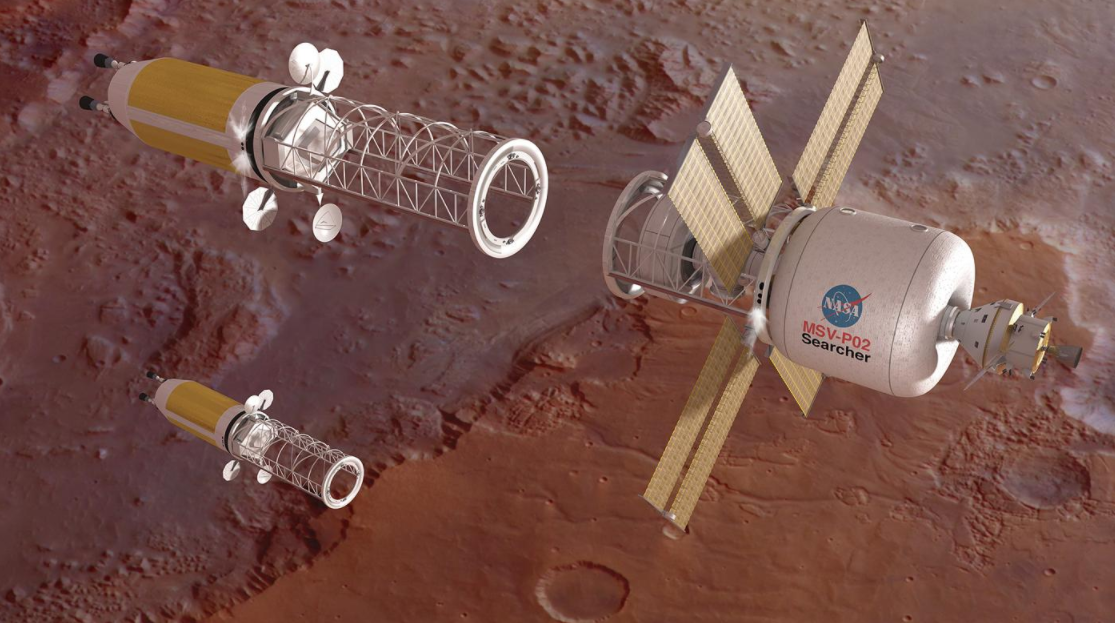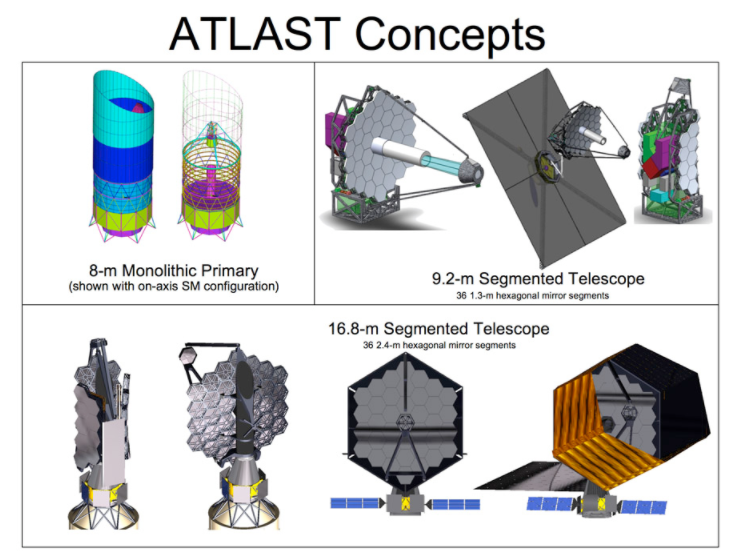NASA's new Space Launch System (SLS) and Orion programs will allow for beyond low-Earth orbit spaceflight. There are a number of notional, proposed missions for the programs, none of which are confirmed.
- orion
- sls
- spaceflight
1. Lunar Missions

1.1. Exploration Mission 1
Exploration Mission 1 is scheduled to be the first mission of NASA's Orion on the Space Launch System. It will spend approximately 3 weeks in space, including 6 days in a retrograde orbit around the Moon.[1] It is planned to be followed by Exploration Mission 2 in 2023.
1.2. Lunar Orbital Platform-Gateway
The Exploration Mission 2 is scheduled to be the first crewed mission of NASA's Orion on the SLS, which will transport the power and propulsion module for the Lunar Orbital Platform-Gateway in lunar orbit. Exploration Missions 2 through 8 would complete the assembly of the Gateway.[2][3][4]
2. Beyond Earth Orbit Orion Missions

2.1. 2033 Forward Work Martian Moon Phobos/Deimos
This is a crewed flexible path mission to one of the Martian moons, Phobos or Deimos. It would include 40 days in the vicinity of Mars and a return Venus flyby.
2.2. 2037–2039 Forward Work Mars Landing
This would be a crewed mission, with four to six astronauts,[5] to a semi-permanent habitat for at least 540 days on the surface of Mars in 2033 or 2045. The mission would include in-orbit assembly, with the launch of seven SLS Block 2 heavy-lift vehicles (HLVs). The seven HLV payloads, three of which would contain nuclear propulsion modules, would be assembled in LEO into three separate vehicles for the journey to Mars; one cargo In-Situ Resource Utilization Mars Lander Vehicle (MLV) created from two HLV payloads, one Habitat MLV created from two HLV payloads and a crewed Mars Transfer Vehicle (MTV), known as "Copernicus", assembled from three HLV payloads launched a number of months later. Nuclear Thermal Rocket engines such as the Pewee of Project Rover were selected in the Mars Design Reference Architecture (DRA) study as they met mission requirements being the preferred propulsion option because it uses proven technology, has higher performance, lower launch mass, creates a versatile vehicle design, offers simple assembly, and has growth potential. A nuclear reactor serving as the power source for Ion propulsion was also an alternative option, in the case NTRs were not available.[6][7][8]
3. Other Proposed Missions
3.1. 2024 Single Launch Mars Sample-Return
This is a crewed flight with a telerobotic Mars sample return mission proposed by NASA's Mars Program Planning Group. The time frame suggests SLS-5, a 105 t rocket to deliver an Orion capsule, a solar electric propulsion (SEP) robotic rover, and a Mars Ascent Vehicle (MAV). "Sample canister could be captured, inspected, encased and retrieved tele-robotically. Robot brings sample back and rendezvous with a crew vehicle." The mission may also include a Mars orbiter with solar electric propulsion.[9]
3.2. Sample Return Missions from the Outer Planets
Concepts for sample return missions to Europa and Enceladus are also being studied.[10]
3.3. Skylab II

Skylab II, proposal by Brand Griffin, an engineer with Gray Research Inc working with NASA's Marshall Space Flight Center in Huntsville, Alabama, to use the upper stage hydrogen tank from SLS to build a 21st-century version of Skylab for future NASA missions to asteroids, Earth-Moon Lagrangian point-2 (EML2) and Mars.[11][12][13]
3.4. Near Earth Object missions
Five near Earth object (NEO) mission concepts have been suggested, ranging from minimum to full capabilities. Among these are two near Earth object missions suggested for in 2026. A 155-day mission to NEO 1999 AO10, a 304-day mission to NEO 2001 GP2, a 490-day mission to a potentially hazardous asteroid such as 2000 SG344, utilizing two Block 1B SLS vehicles,[14] and a Boeing-proposed NEO mission to NEA 2008 EV5 in 2024. The latter would start from the proposed Earth-Moon L2 based Exploration Gateway Platform. Utilising an SLS third stage the trip would take about 100 days to arrive at the asteroid, 30 days for exploration, and a 235-day return trip to Earth.[15]
3.5. High Altitude Venus Operational Concept
This is a crewed Venus mission concept using two SLS Block 1B launches to send a crew of 2 to explore the atmosphere of Venus for 1 month, with retrieval in Earth orbit by a commercial crew vehicle or an Orion.[16][17][18][19]
3.6. LUVOIR Space Telescope

The SLS has been proposed as the launch vehicle for the future Large UV Optical Infrared Surveyor (LUVOIR) space telescope, which will have a main segmented mirror between 8 and 16 meters in diameter,[20] making it 300 times more powerful than Hubble Space Telescope.[21] The two competing concepts to become LUVOIR are ATLAST and HDST. It would be deployed at the Earth-Sun L2 point[20][22] in 2035.[23]
3.7. Europa Clipper
SLS has been proposed as the launch vehicle for the planned Europa Clipper, an orbiter to Europa to study its atmosphere, magnetic and thermal characteristics, gravitational harmonics, sample any water plumes, etc. Its launch is proposed for the mid-2020s.[24]
3.8. Europa Lander
If funded, the launch of a Europa Lander would require the SLS system, and it would be launched after Europa Clipper in the mid-2020s to complement its studies.[25]
3.9. Uranus Orbiter and Probe
SLS has been proposed by Boeing as a launch vehicle for a Uranian probe. The rocket would "Deliver a small payload into orbit around Uranus and a shallow probe into the planet’s atmosphere." The mission would study the Uranian atmosphere, magnetic and thermal characteristics, gravitational harmonics, as well as do flybys of Uranian moons.[22][26]
3.10 Titan Saturn System Mission
SLS has been proposed as a launch vehicle for a probe to Saturn and its moons.[27][28]
3.11. Neptune and Uranus
The 2017 Pre-Decadal Survey on missions to the ice giants, states that a single SLS launch vehicle could launch two spacecraft, one to each ice giant.[29] Launch dates are suggested from 2024 to 2037,[29] and would take about 4 years cruising time for a SLS-1B.[29]
3.12. Deep Space Habitat
Deep Space Habitat are different commissioned concepts developed for NASA that were submitted by Bigelow Aerospace, Boeing, Lockheed Martin, Orbital ATK, Sierra Nevada Corporation, Space Systems Loral, and NanoRacks to build a large enough living space for humans to travel to destinations such as Mars, near Earth asteroids, or cislunar space.[30] The living space would need to be large, so the SLS is a proposed vehicle to launch it.[30][31]
The content is sourced from: https://handwiki.org/wiki/Engineering:Proposed_SLS_and_Orion_missions
References
- Huot, Daniel, ed (27 November 2015). "The Ins and Outs of NASA's First Launch of SLS and Orion". NASA. http://www.nasa.gov/feature/the-ins-and-outs-of-nasa-s-first-launch-of-sls-and-orion. Retrieved 3 May 2016.
- Godwin, Curt (April 1, 2017). "NASA's human spaceflight plans come into focus with announcement of Deep Space Gateway". Spaceflight Insider. http://www.spaceflightinsider.com/organizations/nasa/nasa-human-spaceflight-plans-focus-announcement-deep-space-gateway/. Retrieved 2017-04-02.
- Chris Gebhardt (2015-09-22). "SLS manifest options aim for Phobos prior to 2039 Mars landing". http://www.nasaspaceflight.com/2015/09/sls-manifest-phobos-mars-2039/. Retrieved 2017-03-30.
- "NASA Announces Progress on Asteroid Initiative | NASA". http://www.nasa.gov/press/2015/march/nasa-announces-next-steps-on-journey-to-mars-progress-on-asteroid-initiative. Retrieved 2017-03-30.
- Chris Bergin (2013-10-06). "NASA Con Ops Assess Baseline Features for SLS/Orion Mission to Mars". http://www.nasaspaceflight.com/2013/10/nasa-con-ops-baseline-slsorion-mission-mars/. Retrieved 2017-03-30.
- Chris Bergin (24 January 2012). "SLS Exploration Roadmap evaluations provide clues for human Mars missions". NASASpaceflight.com. http://www.nasaspaceflight.com/2012/01/sls-exploration-roadmap-pointing-dual-mars-approach/. Retrieved 26 January 2012.
- "NASA considers SLS launch sequence for human Mars missions in the 2030s". https://www.nasaspaceflight.com/2015/09/nasa-considers-sls-launch-sequence-mars-missions-2030s/. Retrieved 2017-03-30.
- "Nuclear Thermal Propulsion (NTP): A Proven Growth Technology for Human NEO / Mars Exploration Missions". https://ntrs.nasa.gov/archive/nasa/casi.ntrs.nasa.gov/20120003776_2012004085.pdf. Retrieved 2017-03-30.
- Chris Bergin (30 November 2012). "NASA interest in 2024 Mars Sample Return Mission using SLS and Orion". http://www.nasaspaceflight.com/2012/11/nasa-interest-2024-mars-sample-return-sls-orion/.
- "NASA interested in payload fairing options for multi-mission SLS capability". http://www.nasaspaceflight.com/2012/11/nasa-payload-fairings-options-multi-mission-sls-capability/. Retrieved 2017-03-30.
- Markus Hammonds (14 April 2013). "Skylab II:Living Beyond the Dark Side of the Moon". Discovery. http://news.discovery.com/space/private-spaceflight/skylab-ii-living-beyond-the-dark-side-of-the-moon-130414.htm.
- "Deep Space Habitat module concepts outlined for BEO exploration". http://www.nasaspaceflight.com/2012/03/dsh-module-concepts-outlined-beo-exploration/. Retrieved 2017-03-30.
- Frank Morring, Jr. (22 October 2012). "NASA Deep-Space Program Gaining Focus". Aviation Week & Space Technology. http://www.aviationweek.com/Article.aspx?id=/article-xml/AW_10_22_2012_p34-507657.xml. Retrieved 2017-03-30.
- Marshall Murphy (2013-09-09). "NASA managers evaluate yearlong deep space asteroid mission". http://www.nasaspaceflight.com/2013/09/nasa-evaluate-yearlong-asteroid-mission/. Retrieved 2017-03-30.
- "Long duration ISS crew to lay the foundations for BEO missions". http://www.nasaspaceflight.com/2012/11/long-duration-iss-crew-foundations-beo-missions/. Retrieved 2017-03-30.
- NASA Langley Research Center (October 10, 2014). "A way to explore Venus". YouTube. https://www.youtube.com/watch?v=0az7DEwG68A. Retrieved 2017-03-30.
- "HAVOC | Systems Analysis and Concepts Directorate". 2016-06-15. http://sacd.larc.nasa.gov/branches/space-mission-analysis-branch-smab/smab-projects/havoc/. Retrieved 2017-03-30.
- "Project HAVOC: NASA Concept Could Explore Venus with Airships (Gallery)". 2015-04-20. http://www.space.com/29141-venus-airship-havoc-nasa-concept-gallery.html. Retrieved 2017-03-30.
- "NASA concept would send astronauts to Venus". 2014-12-20. http://www.gizmag.com/nasa-havoc-concept-manned-mission-to-venus/35311/. Retrieved 2017-03-30.
- SLS Launched Missions Concept Studies for LUVOIR Mission. SPIE Optics + Photonics 2015; 9-13 Aug. 2015; San Diego, CA; United States. UV/Optical/IR Space Telescopes and Instruments: Innovative Technologies and Concepts VII; 9-10 Aug. 2015; San Diego, CA; United States. 9 August 2015. https://ntrs.nasa.gov/search.jsp?R=20150018127
- The Space Launch System—the most powerful rocket ever built. Universe Today, published by PhysOrg. 31 July 2017. https://phys.org/news/2017-07-space-systemthe-powerful-rocket-built.html
- Chris Gebhardt (20 November 2013). "New SLS mission options explored via new Large Upper Stage". NASASpaceFlight. http://www.nasaspaceflight.com/2013/11/new-sls-options-new-large-upper-stage.
- Scoles, Sarah (30 March 2016). "NASA Considers Its Next Flagship Space Telescope". Scientific American. https://www.scientificamerican.com/article/nasa-considers-its-next-flagship-space-telescope/. Retrieved 15 August 2017.
- Wall, Mike (5 March 2014). "NASA Eyes Ambitious Mission to Jupiter's Icy Moon Europa by 2025". Space.com. http://www.space.com/24926-nasa-europa-mission-2015-budget.html. Retrieved 2014-04-15.
- JPL moves ahead with Mars and Europa missions despite funding uncertainty. Jeff Foust. July 18, 2017. http://spacenews.com/jpl-moves-ahead-with-mars-and-europa-missions-despite-funding-uncertainty/
- "Space Launch System Exploration, Science, Security" (PDF). Archived from the original on September 23, 2015. https://web.archive.org/web/20150923193950/http://www.boeing.com/assets/pdf/defense-space/space/sls/docs/sls_mission_booklet_jan_2014.pdf. Retrieved 2017-03-30.
- "Archived copy". Archived from the original on March 7, 2016. https://web.archive.org/web/20160307231643/https://www.nasa.gov/sites/default/files/files/Creech_SLS_Deep_Space.pdf. Retrieved 2016-01-15.
- NASA's Space Launch System: A Capability for Deep Space Exploration. (PDF) Stephen Creech, Space Launch System (SLS) Program. https://www.nasa.gov/sites/default/files/files/Creech_SLS_Deep_Space.pdf
- Ice Giants - Pre-decadal Survey. NASA. 2017. https://www.lpi.usra.edu/icegiants/mission_study/Full-Report.pdf
- NASA reveals six concepts for its deep space habitat. Cheyenne Macdonald, Daily Mail. 28 July 2017. http://www.dailymail.co.uk/sciencetech/article-4740478/NASA-reveals-six-concepts-deep-space-habitat.html
- Boeing's deep space habitat could be home for Mars astronauts. Mariella Moon, engadget. 4 April 2017. https://www.engadget.com/2017/04/04/boeing-deep-space-habitat-transport-concept-images/
